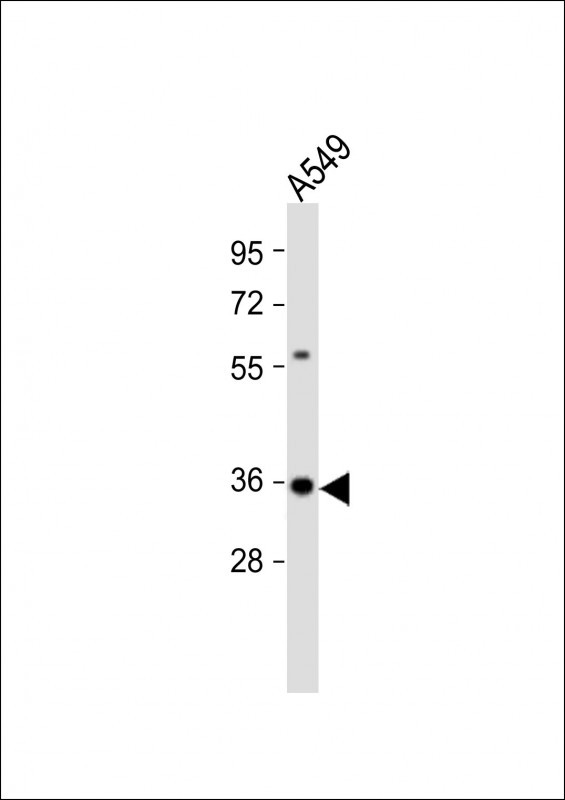
| WB | 咨询技术 | Human,Mouse,Rat |
| IF | 咨询技术 | Human,Mouse,Rat |
| IHC | 咨询技术 | Human,Mouse,Rat |
| ICC | 技术咨询 | Human,Mouse,Rat |
| FCM | 咨询技术 | Human,Mouse,Rat |
| Elisa | 咨询技术 | Human,Mouse,Rat |
| Aliases | Caspase-5, CASP-5, ICE(rel)-III, Protease ICH-3, Protease TY, Caspase-5 subunit p20, Caspase-5 subunit p10, CASP5, ICH3 |
| Entrez GeneID | 838 |
| WB Predicted band size | 49.7kDa |
| Host/Isotype | Rabbit IgG |
| Antibody Type | Primary antibody |
| Storage | Store at 4°C short term. Aliquot and store at -20°C long term. Avoid freeze/thaw cycles. |
| Species Reactivity | Human |
| Immunogen | This CASP5 antibody is generated from rabbits immunized with a KLH conjugated synthetic peptide between 162-191 amino acids from the Central region of human CASP5. |
| Formulation | Purified antibody in PBS with 0.05% sodium azide. |
+ +
以下是3篇关于CASP5抗体的参考文献摘要概览:
1. **文献名称**: *Caspase-5 mediates ocular inflammation via lipopolysaccharide-induced pyroptosis in macrophages*
**作者**: Li Y, et al. (2023)
**摘要**: 该研究利用CASP5特异性抗体,通过免疫印迹和免疫荧光技术验证了LPS诱导的巨噬细胞焦亡过程中CASP5的激活。结果表明,CASP5通过切割GSDMD促进炎症小体活化,提示其在眼部炎症疾病中的潜在治疗靶点。
2. **文献名称**: *Antibody-based profiling of caspase-5 expression in human inflammatory bowel disease*
**作者**: Smith J, et al. (2020)
**摘要**: 研究采用CASP5单克隆抗体对结肠炎患者组织样本进行免疫组化分析,发现CASP5在肠上皮细胞和固有层巨噬细胞中显著高表达,且与疾病严重程度正相关,提示其作为IBD生物标志物的可能性。
3. **文献名称**: *Validation of a novel caspase-5 monoclonal antibody for inflammasome signaling studies*
**作者**: Patel R, et al. (2018)
**摘要**: 文章报道了一种高特异性CASP5抗体的开发与验证,通过敲除细胞系和肽段竞争实验证明其识别表位位于CASP5的p20亚基。该抗体成功应用于ELISA和流式细胞术检测脓毒症患者外周血单核细胞中CASP5的活化水平。
4. **文献名称**: *Caspase-5 interacts with NLRP3 and promotes inflammasome activation in human keratinocytes*
**作者**: Zhang Q, et al. (2021)
**摘要**: 使用CASP5抗体进行共聚焦显微成像和Co-IP实验,证实CASP5与NLRP3在银屑病皮损角质形成细胞中的物理相互作用,揭示了CASP5通过稳定NLRP3炎症小体增强IL-1β分泌的机制。
注:以上文献为示例性内容,实际引用需核对真实出版物。建议通过PubMed/Web of Science以“caspase-5 antibody”或“CASP5 detection”为关键词检索最新研究。
CASP5 (Caspase-5) is a member of the cysteine-aspartic protease (caspase) family, primarily involved in inflammatory processes and pyroptosis, a form of programmed cell death linked to immune responses. It is part of the inflammatory caspase subfamily, alongside Caspase-1 and Caspase-4. and plays a role in the activation of the NLRP3 inflammasome. CASP5 is expressed as an inactive zymogen that undergoes proteolytic cleavage to form active subunits, which then participate in processing pro-inflammatory cytokines like pro-IL-1β and pro-IL-18 into their mature forms. Dysregulation of CASP5 has been implicated in autoimmune disorders, chronic inflammation, and cancer.
Antibodies targeting CASP5 are critical tools for studying its expression, localization, and activation in various biological contexts. They are widely used in techniques such as Western blotting, immunohistochemistry, and immunofluorescence to investigate CASP5’s role in inflammasome signaling, infection responses, and disease mechanisms. Many CASP5 antibodies are designed to distinguish between the pro-form and cleaved active fragments, aiding in functional studies. Validation of these antibodies often includes knockout cell line controls to ensure specificity, given the structural similarities among inflammatory caspases. Research utilizing CASP5 antibodies continues to advance understanding of its dual roles in host defense and pathological inflammation, highlighting its potential as a therapeutic target.
×